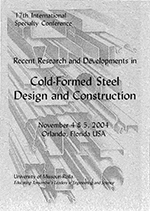Session Dates
26 Oct 2006
Abstract
This paper presents an analytical method to calculate the buckling stress of a rectangular thin plate under nonuniform applied axial stresses. Two cases are considered, buckling of a plate simply supported on all four sides and buckling of a plate simply supported on three sides with one unloaded edge free and the opposite unloaded edge rotationally restrained. These two cases illustrate the influence of stress (moment) gradient on stiffened and unstiffened elements, respectively. The axial stress gradient is equilibrated by shear forces along the supported edges. A Rayleigh-Ritz solution with an assumed deflection function as a combination of a polynomial and trigonometric series is employed. Finite element analysis using ABAQUS validates the analytical model derived herein. The results help establish a better understanding of the stress gradient effect on typical thin plates and are intended to lead to the development of design provisions to account for the influence of moment gradient on local and distortional buckling of thin-walled beams.
Department(s)
Civil, Architectural and Environmental Engineering
Research Center/Lab(s)
Wei-Wen Yu Center for Cold-Formed Steel Structures
Meeting Name
17th International Specialty Conference on Cold-Formed Steel Structures
Publisher
University of Missouri--Rolla
Document Version
Final Version
Rights
© 2006 University of Missouri--Rolla, All rights reserved.
Document Type
Article - Conference proceedings
File Type
text
Language
English
Recommended Citation
Yu, Cheng and Schafer, Benjamin W., "Stress Gradient Effect on the Buckling of Thin Plates" (2006). CCFSS Proceedings of International Specialty Conference on Cold-Formed Steel Structures (1971 - 2018). 4.
https://scholarsmine.mst.edu/isccss/17iccfss/17iccfss-session1/4
Stress Gradient Effect on the Buckling of Thin Plates
This paper presents an analytical method to calculate the buckling stress of a rectangular thin plate under nonuniform applied axial stresses. Two cases are considered, buckling of a plate simply supported on all four sides and buckling of a plate simply supported on three sides with one unloaded edge free and the opposite unloaded edge rotationally restrained. These two cases illustrate the influence of stress (moment) gradient on stiffened and unstiffened elements, respectively. The axial stress gradient is equilibrated by shear forces along the supported edges. A Rayleigh-Ritz solution with an assumed deflection function as a combination of a polynomial and trigonometric series is employed. Finite element analysis using ABAQUS validates the analytical model derived herein. The results help establish a better understanding of the stress gradient effect on typical thin plates and are intended to lead to the development of design provisions to account for the influence of moment gradient on local and distortional buckling of thin-walled beams.



